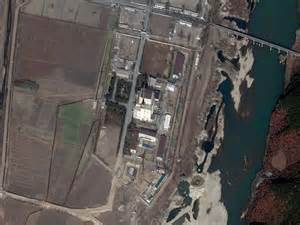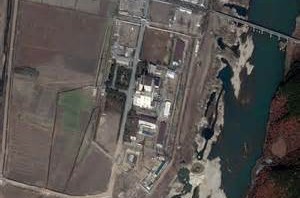No one really wants to admit the effectiveness and reality of the North Korea nuclear program but it is real. The real objective of the global leaders is to determine what is next. Global Hawks, eyes in the sky along with Geo-Spatial systems are taking pictures for sure, but analyzing the scope of the North Korean objectives continues to pose future estimates and targets as well as timelines.
U.S. researchers detect increased activity at North Korea’s nuclear test site but remain unsure when an underground explosion might happen.
South Korea said last week, as President Barack Obama toured East Asia, that the North appeared ready to conduct its fourth nuclear test since 2006 at Punggye-ri (PUNG-gare-ree).
The North Korea-watching website 38 North says commercial satellite images taken Tuesday show vehicles and equipment outside a tunnel entrance. It says past practice suggests those would all be withdrawn immediately before any blast.
The imagery also shows possible signs of digging at another part of Punggye-ri, further sign a test isn’t imminent.
The Washington-based Institute for Science and International Security said VIPs may have recently visited the site and a test could happen soon, but it’s difficult to determine when.
It is time to question the assessments and the abilities and then the truth of what is being reported by the U.S. government officials and the United Nations.
A recent unclassified Defense Intelligence Agency (DIA) assessment stated: “DIA assesses with moderate confidence the North [Korea] currently has nuclear weapons capable of delivery by ballistic missiles.” This conclusion is highly credible and not really new. North Korea was assessed to have nuclear weapons long before the actual (or at least detected) first test of these weapons in 2006. Building a nuclear weapon small enough to be carried by the relatively large payloads of North Korea’s ballistic missiles is not a very difficult task today. In light of what is now known about the proliferation of a nuclear missile warhead from China to Pakistan and from Pakistan to North Korea, the North Korea defector reports about nuclear weapons development and the North Korean nuclear tests, the DIA conclusion may be an understatement. The North Korean nuclear stockpile may be significantly greater than what is usually assessed. This is of concern because the North Korean regime is the most brutal Stalinist dictatorship in the world. Moreover, while North Korea has long made occasional nuclear attack threats against the U.S. in the past, the scope, magnitude, and frequency of these threats vastly increased in 2013. Current U.S. policy, which downgrades the importance of nuclear deterrence and cuts missile defense, is not well suited to handle this threat.
Read more on a related study here.
Overview Last updated: February, 2014
The Democratic People’s Republic of Korea (DPRK) has an active nuclear weapons program and tested nuclear explosive devices in 2006, 2009, and 2013. It is also capable of enriching uranium and producing weapons-grade plutonium. North Korea deploys short- and medium-range ballistic missiles and successfully launched a long-range rocket in 2012. Pyongyang unilaterally withdrew from the Treaty on the Non-Proliferation of Nuclear Weapons (NPT) in January 2003 and is not a party to the Comprehensive Nuclear-Test-Ban Treaty (CTBT) or a member of the Missile Technology Control Regime (MTCR). The DPRK is not a party to the Chemical Weapons Convention (CWC), and is believed to possess a large chemical weapons program. North Korea is a party to the Biological and Toxin Weapons Convention (BTWC), but is suspected of maintaining an offensive biological weapons program in defiance of that treaty.
Nuclear North Korea’s interest in a nuclear weapons program reaches back to the end of World War II. Since then, Pyongyang developed a nuclear fuel cycle capability and has both plutonium and enriched uranium programs capable of producing fissile material. North Korea declared that it had roughly 38.5kg of weapons-grade plutonium extracted from spent fuel rods in May 2008, however external estimates have varied.[1] In November 2010, North Korea unveiled a uranium enrichment program ostensibly intended to produce low enriched uranium for power reactors, though it is possible for Pyongyang to produce highly enriched uranium for weapons purposes.[2] North Korea conducted three nuclear weapons tests in 2006, 2009 and 2013.[3]
The Six-Party Talks between North Korea, South Korea, Japan, China, Russia, and the United States began in 2003 with the goal of denuclearizing the Korean Peninsula. However, these talks have been suspended since April 2009. Initial uncertainties about North Korea’s nuclear program after the death of Kim Jong Il were tempered when Pyongyang agreed to suspend nuclear tests, uranium enrichment, and long-range missile tests in exchange for food aid from the U.S. on 29 February 2012.[4] After a dispute with the United States over the launch of a rocket in April 2012, North Korea declared the agreement void, and later conducted a nuclear test in February 2013.[5] In April 2013, North Korean state media announced that Pyongyang would restart all nuclear facilities at Yongbyon, including its 5MW graphite-moderated reactor, and uranium enrichment plant.[6] By August 2013, satellite imagery confirmed steam venting from the 5MW reactor’s turbine and generator building.[7]
Biological
Although the DPRK acceded to the Biological and Toxin Weapons Convention (BTWC) in 1987, it is suspected of maintaining an ongoing biological weapons program. Defectors from the DPRK and the defense agencies of the United States and South Korea generally agree that the country began to acquire a biological weapons capability in the early 1960s.[8] However, open source information on the DPRK’s biological weapons program varies considerably. The 2010 Defense White Paper by South Korea’s Ministry of National Defense, estimates that the DPRK possesses the causative agents of anthrax, smallpox, and cholera, among others.[9]
Chemical
The DPRK’s pursuit of chemical weapons dates back to 1954. It most likely obtained indigenous offensive CW production capabilities in the early 1980s.[10] The DPRK’s CW agent production capability is estimated to be up to 5,000 metric tons per year. Pyongyang has concentrated on acquiring mustard, phosgene, sarin, and V-type chemical agents.[11] Reports indicate that the DPRK has approximately 12 facilities where raw chemicals, precursors, and actual agents are produced and/or stored, as well as six major storage depots for chemical weapons.[12] Pyongyang also has placed thousands of artillery systems — including multiple launch rocket systems that would be particularly effective for chemical weapons delivery — within reach of the Demilitarized Zone and Seoul.[13] North Korea has not signed the Chemical Weapons Convention (CWC).
Missile
North Korea began its missile development program in the 1970s and tested a Scud-B ballistic missile by April 1984. North Korea is not a member of the Missile Technology Control Regime (MTCR).
In its short-range arsenal, Pyongyang has produced the 500km-range Scud-C, the 700km-range Scud-D, and the solid-fueled KN-02, which is an upgraded version of the Russian SS-21 “Scarab” with a slightly longer range of about 120km. In its medium and intermediate-range arsenal, North Korea has the 1,300km-range missile known as the Nodong (Rodong), which it initially tested in 1993 (500km), and again in 2006. North Korea has deployed between 175 and 200 Nodong missiles.[14] Pyongyang has also displayed its Musudan IRBM in parades, although it has never flight tested it. A yet-unnamed Nodong-variant was also displayed in October 2010, which possesses visible similarities to Iran’s Ghadr-1.[15] North Korea’s Taepodong-1 (Paektusan-1), an 1800km-range space launch vehicle has also been flight-tested. North Korea’s three-stage Taepodong/ Unha SLV has been tested with varied success.[16]
North Korea agreed to a moratorium on long-range missile tests in exchange for food aid from the U.S. on 29 February 2012.[17] However, on 12 April, it attempted to launch the Kwangmyong-3 satellite into orbit using an Unha-3 launch vehicle. The launch failed after approximately 80 seconds, and the debris landed off the western coast of South Korea. The U.S. government withdrew its offer of food aid because it considered the space launch, which relied on missile technology, a violation of the bilateral agreement as well as UN Security Council resolutions 1718 and 1874.[18] On 15 April, North Korea displayed six never before seen missiles in a parade in honor of its founder Kim Il Sung. These missiles, known externally as KN-08s, are likely only mock-ups.[19] The missiles were displayed on six trucks of Chinese-origin that were converted to transporter-erector-launchers (TELs).[20] On 12 December 2012, North Korea reattempted its Unha-3 launch, successfully putting a Kwangmyong-3 satellite into orbit.[21] This test proves a significant advancement in North Korean missile technology. With only slight modifications for re-entry the rocket could deliver a very small payload, though without great accuracy.
Pyongyang has also tested anti-ship cruise missiles numerous times since 1994. The North Korean missile identified as the AG-1 is based on the Chinese CSSC-3 ‘Seersucker’. Anti-ship cruise missile tests on 25 May and 7 June 2007 are believed to have been either the KN-01 or the Chinese-made CSSC-3 ‘Seersucker’.[22]
Citations on the above are here.


